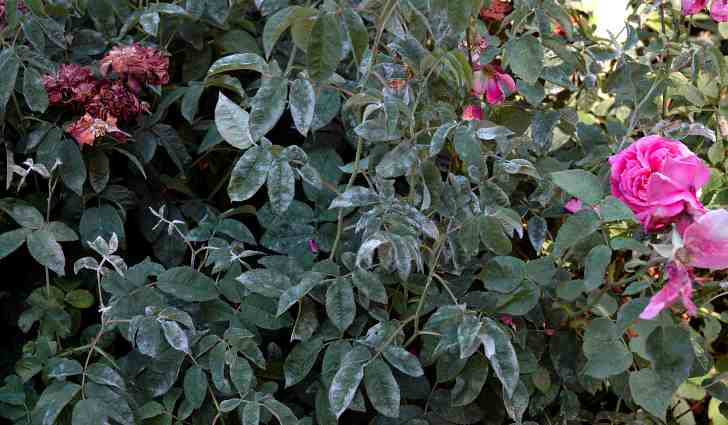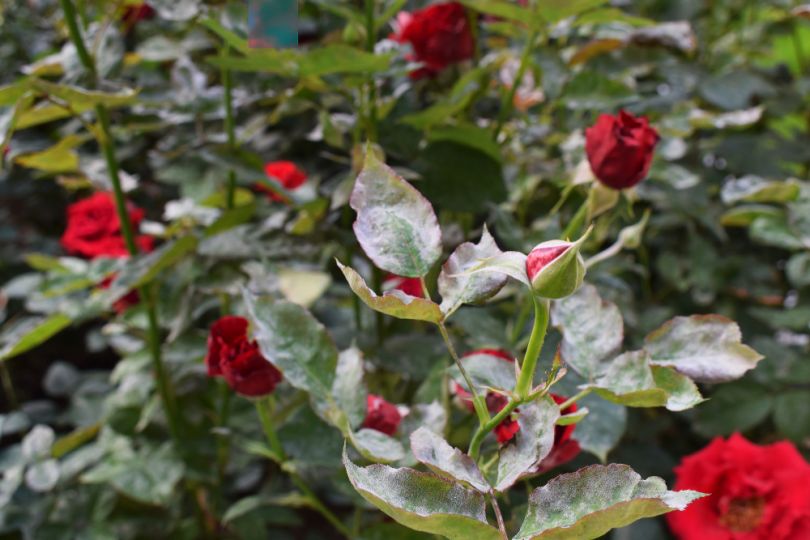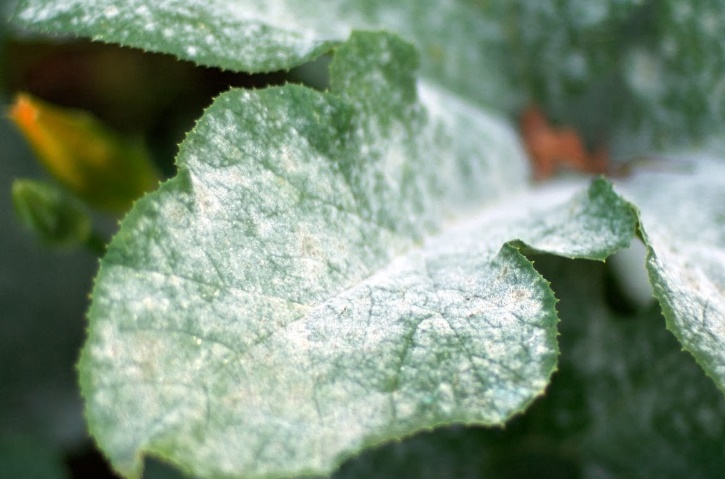We humans do not like to be ill. Similarly with plants, only they can’t tell us about it. There is such an all-season disease in our favorite plants – powdery mildew on roses. All-season because roses are grown throughout the year in the open and closed ground. The truth is that it can easily destroy a flower if we don`t respond in time.
How to find powdery mildew on roses
Powdery mildew on roses is the result of the attack of the fungus Sphaerotheca pannosa Lew. var. Rosae Voron. This insidious disease develops quite quickly and can migrate to healthy roses with the same speed. The initial stage by which you can recognize the ailment is a powder-like whitish coating on the leaves.

First of all, the parts of the plant that are closest to the ground suffer. How much time will pass from infection to visible signs of illness? This time depends on the sustainability of the variety of roses to it. Some varieties quickly fall ill, others resist for a long time. Young and only planted plants are more prone to powdery mildew. Weather conditions also affect the ability to get sick with it. But approximate with the rock manifestations of visible traces range from 3 to 12 days.
When the spores of the disease ripen, droplets of contagious “dew” will appear on the plaque. So the disease got its name. Over time, the plaque turns yellow, turns brown, etc., and the plant becomes sluggish, loses its beauty and health.
During the year, powdery mildew can repeat up to 10-15 times, and under attractive conditions, and 20-25 times (remember? Quickly develops).
To be armed and in time to defeat an insidious enemy, one must look for him not only on the leaves. Inspect regularly shoots and rosebuds. In a state of neglect, at some phase of the generation of the disease, powdery mildew affects the fruit. For those who are engaged in or trying to engage in selection, this scenario is not at all appropriate. By the way, the fruit – a great place to winter spore fungus.
Where powdery mildew waits for the roses
The primary cause of the appearance of such a disease as powdery mildew on roses is overwintering the fungus spores around the plants. Where is she, such a plague, hiding?
- In the ground. “What fell is gone” is not the phrase that characterizes the sad end of the powdery mildew spores. The soil is a sponge in which it hibernates beautifully.
- In plant residues waiting for its hour mass of pathogens
- On sick seedlings we are bringing the infection into our garden
- On dirty tools any pathogenic evil remains that we pass from one plant to another with our own hands
- In the neighboring gardens, especially those that are not well-groomed, are sources of various
Factors that contribute to the spread of powdery mildew

- Air humidity is the most important factor that showed the highest growth effect and spread pathogenic fungus
- low or too high temperatures in combination with moisture helping to spread disease
- Swings day and night temperature enhance kill probability roses mildew half if them poorly cared
- Prolonged hot weather and high humidity also can provoke of the disease
- Cold rains in the summer – this is one of the causes of not only the mildew, but other fungal diseases
- Of nitrogen oversupply doesn’t allow the plant time to mature, to strengthen your immune system, and stimulates the growth of new shoots
- Negative / overabundance of moisture (incorrect irrigation) is also a frequent occurrence of a provocateur wide variety of diseases
- Too much thick planting – the surest way to landings to the disease quickly turn your garden of paradise blooming in zombilend
- No weeding and loosening the soil do not allow oxygen and moisture to penetrate to the root system, and also helps to breed the weeds.
How to avoid powdery mildew on roses
There are several reinforced concrete rules that have long been used by both professionals and amateurs. They at least half reduce the opportunity to settle powdery mildew on roses. These techniques also work with other plants.
- Planting resistant varieties of roses
- Planting in well-lit and ventilated areas of the sun
- Do not plant too close to each other
- Regularly monitor the soil around your roses;
- Carry out preventive treatments against powdery mildew
- Regularly and correctly feed the roses
- Properly and in a timely manner; water the plants
- Never water the roses in the bush but only on the ground of the area of occurrence of the root
- System, always turn around their roses
- Deeply dig the soil around the plants
- A regular inspection of roses
How to kill powdery mildew on roses
Few rules that will help make the treatment of roses against powdery mildew more effective.
- Cut the diseased part of the plant
- To scavenge
- Spray in the evening hours in calm dry weather
- Thoroughly moisten plants prepared mixtures
- Sure to treat the soil around your plants
Traditional methods of combating powdery mildew
Adherents of the popular methods to control powdery mildew on roses suitable methods described below. Every remedy is done again every time so that it is fresh. Folk solutions have no shelf life.

- An aqueous solution of soda. 50 g of soda and 40 g of laundry soap should be dissolved in 10 liters of water. Roses are treated with this solution twice. The interval between treatments 1 week.
- Insulin from mullein. One-third of a 10-liter bucket of fresh manure insist three days in 10 liters of water. Then filter it. For processing take 1 part of the infusion and 10 parts of water.
- 80 g chopped garlic pour 10 liters of hot water. When the infusion has cooled, carry out processing.
- In 10 l of water dissolve 2, 5 g of potassium permanganate. Roses are processed three times with an interval of 5 days.
- In 10 liters of hot water dissolve 2 tbsp. ground grain mustard. Spray the roses after the solution has cooled.
- 1 kg of wood ash insist week in 10 liters of water. Then it is filtered and treated plants every other day.
- Infusion of nettle or horsetail. For 1 liter of hot water take 100 g of dry grass. Use as soon as the infusion has cooled. Fresh grass you need 2 times more. By the way, such infusions can be prophylactic.
- 1 l of whey, 10 drops of iodine dissolved in 5 l of water. Sprayed immediately.
- 1 tbsp soda ash, 1 tbsp. liquid soap and 1 cup (0.24 l) of wood ash dissolved in 10 liters of water. The treatment is carried out every 10 days until the complete disappearance of the disease.
Treatment of powdery mildew with preparations
Often, folk help, but not for long or at all, they do not cope with powdery mildew on roses. Then you have to turn to chemistry for help. For the treatment against this disease on the market there are many drugs. The same solutions from Bordeaux mixture or copper sulfate. Well cope with the disease fungicides – drugs to combat fungal plant diseases. The only advice is not to constantly use the same drug so that the disease does not develop immunity. Alternate them and you will surely beat powdery mildew on your roses. Remember also about your safety when working with such tools and prepare them according to the instructions.
You can take advantage of bio-fungicides. They will not help you so quickly, but they are less toxic and cause less harm to the environment.
Let no diseases come to your garden! Enjoy your growing and easy struggle!